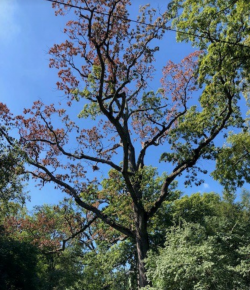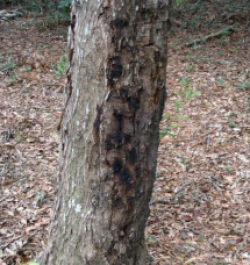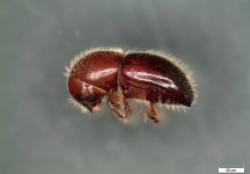Riverwoods Village Hall
300 Portwine Rd.
Riverwoods, IL 60015
Office Hours: M-F, 8:30am - 1:30pm
Phone: 847-945-3990
Fax: 847-945-4059
Observations of declining oak species across large geographic regions are increasing. The convergence of multiple stress factors, both abiotic and biotic, can lead to widespread tree declines. These factors include extreme shifts in soil moisture conditions, proliferation of root diseases, and secondary infestations of wood boring pests. Trees in advanced stages of decline may not recover, but if the decline is detected early enough, remedial treatments may be able to aid recovery.

A decline is a loss of vigor (health) and vitality (endurance) caused by the accumulation of multiple biotic and abiotic stress factors. This term can be applied to an individual tree or a population of one or more species. A species decline occurs when widespread abiotic conditions, such as drought or excess soil moisture, stress a population of trees and interact with secondary infestations of disease and insects.
Since declines occur due to a complex of factors interacting over time and symptoms are often not immediately apparent, it can be difficult to identify a tree in the early stages of decline. This explains why it may seem like an apparently healthy tree “died overnight.” Extreme temperature shifts are also a major contributing factor to tree declines. White oaks are generally more tolerant than red oaks, but earlier springs, hotter summers, and longer autumns, are impacting both oak groups.
When waterlogging or drought occurs across an area, this can predispose trees to secondary diseases and insect attacks, especially if these abiotic stressors occur across multiple years. Oaks existing in poorly draining soils, such as clay and compacted soils, are more prone to flooding stress during periods of heavy rainfall. Flooded conditions can lead to anaerobic (oxygen depleted) environments where roots can become limited or die. Waterlogged conditions also predispose oaks to root rot diseases. Trees in soils with limited water-holding capacity, such as sand, are more susceptible to stress during droughts.

The two major diseases associated with declines in eastern North America are Phytophthora root rot and basal canker (Figure 2) and Armillaria root rot. Both diseases are associated with flooding, and Armillaria can also be found after periods of drought. Hypoxylon canker is also associated with declining oaks. Other regional diseases can kill oaks outright. Examples include bacterial leaf scorch, oak wilt (distributed in the Midwest, Texas, and parts of the east coast), and sudden oak death (found only on the west coast).
Primary wood-boring insects do not attack healthy oaks in eastern North America. In California, the goldspotted oak borer (Agrilus coxalis) can kill healthy oaks. When oaks become stressed, they release chemical compounds detectable by secondary wood borers that attack the trees. Some of these pests are the black stem borer (Xylosandrus germanus, an ambrosia beetle), the granulate ambrosia beetle (X. crassiusculus, Figure 3), the two-lined chestnut borer (Agrilus bilineatus, a flatheaded borer) and the red oak borer (Enaphalodes rufulus, a long-horned beetle). Some defoliating insects, such as gypsy moth (Lymantria dispar) and winter moth (Operophtera brumata), can predispose trees to decline, especially after consecutive years of defoliation and in conjunction with a flood or drought event.

Encouraging overall plant health is the best way to prevent a tree from succumbing to decline. For urban and landscape trees this means trying to mimic forest conditions. The first step is determining the soil chemistry (pH, nutrient levels, organic matter) and texture. Prescribed fertilization treatments, based on soil analysis results, in combination with cultural treatments such as proper water management and mulching to the drip line with wood chips, will reduce the likelihood of oak decline. These treatments are more effective when applied proactively before decline begins.
If detected early enough, preventive disease and insect pest applications can ward off further decline while cultural issues are remediated. Unfortunately, once a decline is set in motion, it can be challenging to reverse since it is associated with a complex of problems! Predictions of warmer and longer summers mixed with more extreme weather events may not bode well for the future of our landscape oaks. Since it is difficult to reverse decline in a mature tree, it is vital to ensure healthy growing conditions throughout its life.
For more information on Oak Diseases and Oak Decline click here to view the presentation by the Riverwoods Village Ecologist.